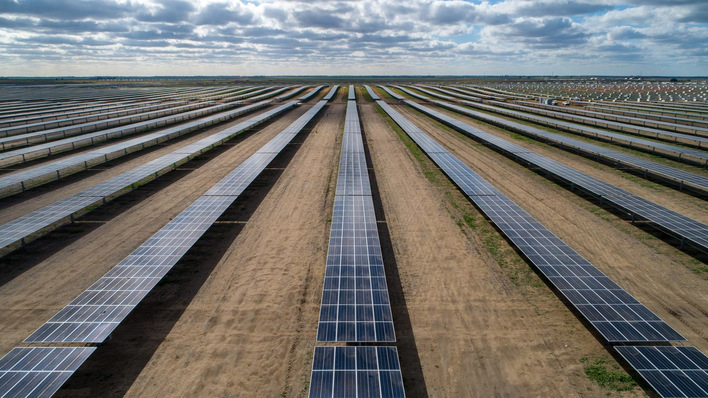Every battery module of the Myreserve has an output of 800 watts. Now you have come out with the new matrix system that allows the combination of any number of battery packs. What consequences does that have on the overall unit’s performance?
Up to five battery packs are combined with a command unit which thus controls four kilowatts. The battery packs are connected in series and so, of course, the voltages add up. Every battery pack has 50 volts, so five packs together have 250 volts. The currents remain below 16 ampere, that was important to us. The systems output scales up according to the number of battery modules.
Why were you so keen on limiting the systems current?
In building power supply, 16 ampere are considered a standard for fuses. Exceeding this amperage makes the necessary cables, fuses and so on much more expensive. Also, higher currents cause greater losses in the system. So we increase the output by raising the voltages. The Matrix is so far certified for 250 volts, but it could achieve up to 750 volts. That would be 15 battery modules connected in parallel and with a total output of 12 kilowatts. We shall see if we will one day be able to realise this technical possibility.
Storage units are so far mostly designed according to capacity, i.e. the kilowatt hours that they can store. Will their charging and discharging output become more significant in the future?
I assume so. With falling battery prices and, for instance, rising demand because of electric mobility, stationary batteries will have to increase their output. Because a customer might want to charge their car overnight. So, yes that will come.
The MyReserve 800 will be integrated into the solar string and controlled by the inverter’s MPP tracker. How many strings can you connect to the Matrix?
Currently two. However, the system is based on a concept of clusters so that we will eventually be able to connect up installations with multiple strings. With two storage units with two strings each, one unit acts as the master unit and the other as its slave connected in parallel. They share the providing of electricity according to the demand from the building’s internal grid. The overall system is controlled to maximise service life: The storage units act in such a way that the batteries deteriorate as little as possible. The new units are already pre-configured to operate with clusters.
Why not more than two strings?
That will come in early 2018. The number of controllable strings, i.e. the cluster consisting of a command unit and a certain number of battery packs, is determined by the length of the bus cable. That must not exceed 150 metres, otherwise a signal amplifier is required.
Because the storage units are integrated into the PV string and are managed via the MPP tracker, neither the MyReserve nor the Matrix require a separate inverter. Does that work with all common models?
According to our experience, yes. So far we have had no problems, not even with older inverters. The one exception is SolarEdge, because their inverters communicate with the DC optimisers via the power line, i.e. through the DC cable from the solar panels to the input of the inverter. The high-frequency signal cannot make it past the capacitors of our storage unit. This creates a conflict.
Will you be able to solve the problem?
We understand what the issue is and will soon solve it. The key is that our storage units have to be able to deal with the MPP trackers of the other inverters. And SolarEdge do their MPP tracking in the DC optimiser within the solar panel. One solution might be to connect a communication bypass. Then our storage unit would also work with SolarEdge inverters.
Solarwatt is determined to stay with DC systems. Why not do what many of your competitors are doing and abandon DC in favour of AC systems?
Because we believe that this is the wrong decision. We will continue to harvest the solar power on the DC side. It is the most efficient way. In case of multi-string systems, we will need an AC charger, however. But that is also required to integrate fuel cells or small wind turbines, i.e. combine a number of generators. This will only be used for charging, while discharging will always happen via the inverter. That reduces complexity and keeps costs down.
Why will you not build a discharger?
The AC charger gives (municipal) utilities the opportunity to pursue new business models using our storage units. For instance, the units can act as a buffer in case of a surge in the grid – as a swarm or as part of a virtual power plant. To make that possible, the AC charger will have a data port in accordance with IEC 61850.
What are you doing about grid feed-in?
The solar inverter would be able to do that just as well or better. Mono-directional AC power electronics is much less expensive than bi-directional inverters with feed-in capabilities. An AC charger would be treated as an electricity consumer rather than a grid-connected generator. That would also solve a number of tax and other legal considerations.
Is it possible that it would make monitoring of the storage unit easier? AC systems usually have a monitoring portal for the solar inverter and a portal for the storage unit...
Because the storage unit is practically invisible to the monitoring system of the inverter, our monitoring is taken care of by one app and through one Bluetooth interface. After all, the battery runs through the MPP tracker, just like the solar string. But generally speaking, you are right: Monitoring is also less complicated if one continues to operate in DC.
What will the future hold for the power electronics of storage units?
On the one hand, I see storage manufacturers focussing their efforts on electronics and control software. This is our USP and we do not intend to let go of it. The software that controls the battery is very important even today. It impacts about 50 percent of the battery’s performance.
What do you mean by that?
The software that controls the storage unit, i.e. the battery management system, responsible for the battery’s rate of control, for regulating the load conditions and for gathering operational data. Rather than by way of the cells’ capacity, we measure the so-called ‘state of health’ by way of the internal resistance. Every battery module contains 12 cells, whose individual internal resistance has to be measured in real time. The overall computing power of a storage system is already greater than that of a laptop computer. To give just one figure: Our control software consists of 250,000 lines of code.
How important is IT security?
That has the highest priority for us. We will not allow third-party firmware as part of our storage units. Our partners can only access the battery through the data port in the AC charger that I mentioned before, allowing them to use it for their business models. In order to update the firmware, the technician has to access the unit via his laptop or smartphone to activate the Bluetooth connection manually. Externally uploading the firmware over the Internet is, in my opinion, a risky proposition. It is impossible to safeguard that no unauthorised person gains access to the system. Just imagine: Hackers set all batteries are to overcharge all at once. They would all blow up together.
The prices for lithium cells continue to fall. So for power electronics cost is becoming more and more of a factor. What can be done to reduce costs here?
First and foremost by mass-producing battery systems. Our Matrix system is one more step in that direction and demand seems to vindicate our approach. On the other hand, I am expecting technical advances in charging electronics. It may even be possible for it not to be necessary at all. We have recently acquired a patent for charging a battery directly from solar power, without a DC controller.
Sounds interesting. How would that work?
The idea is so simple and brilliant that one might almost be annoyed at not having thought of it ourselves. It has been well-known for a while that the performance curves of solar strings and lithium ion batteries are quite similar. They are a very good match, even without a voltage inverter between them. The same cannot be said for led cells. They have completely different charging characteristics. As part of a global selection process, we came across an interesting patent which takes this idea to its logical conclusion.
Can you outline the key features of this patent?
The storage unit is integrated into the solar string as a voltage sink by connecting the positive lead from the solar panels to the positive pole of the battery and the negative pole of the battery to the positive input of the inverter. Conventionally, the positive pole of the battery has been connected to solar positive and negative with negative. The patent’s solution means that the battery is connected serially as part of the positive lead of the solar string. That way the inverter treats the battery as a sink that lowers the voltage of the solar string by its own operating voltage.
Would you mind if we went through the figures?
Sure, it is amazingly simple. Imagine the solar string produces 400 volts and the battery is charged at 100 volts, the inverter only recognises 300 volts. A DC-DC converter is no longer necessary. This means that there is no loss in output otherwise caused by the electronics and we can achieve a charging efficiency of 99 percent. However, there is one catch.
What would that be?
Discharging, which is controlled by the power demand of the building and is not as trivial as charging. Shall we have the inverter manage discharging or will we include a specialised DC discharging system on the DC side? We will have to take a closer look at that. We own the patent for the next 20 years, rather than just licences, and we will see how we are going to make use of it. But you can be sure that we did not just buy this patent to hide it away somewhere.
The interview was conducted by Heiko Schwarzburger.
Stay informed, get our newsletter. Register here: http://www.pveurope.eu/Newsletter
More useful information about energy storage systems:
Energy storage: costs, prices and finance at a glance
Get all the new products for energy storage here.
Energy storage: our insight stories at a glance
Energy storage: our expert’s interviews at a glance
Energy storage for commercial use: all reports at a glance
Solar panels:
Choose your right solar panels
Electric cars:
Learn about electric cars to make more use of energy storage







